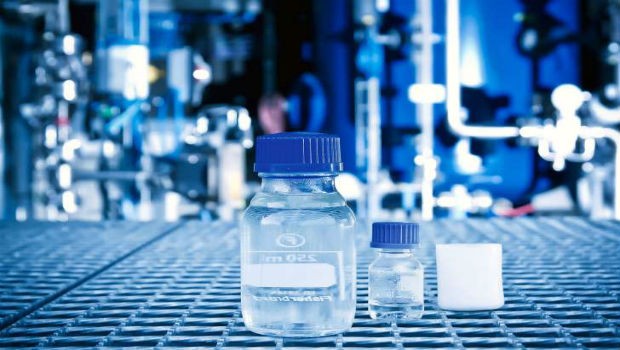
By Ian Crossland at awnn.com
A breakthrough refinement process perfected by Audi engineers has produced a diesel fuel created from high temperature water and carbon dioxide.
After only four months, the plant, run by clean technology company Sunfire, was able to produce its first batch of the fuel, dubbed “blue crude.” the product is composed of long-chain hydrocarbon compounds, similar to fossil fules, but does not contain sulfer or aromatics and burns without producing any soot.
It’s called the Fischer-Tropsch process and has been around since the 1920s, but has never been done at such high temperatures. It’s the high temperatures that yield the reward.
So what is it?
It begins with a renewable energy source (wind, solar or hydropower). The energy heats water in excess of 1472 degrees farenheit. This superheated steam is then broken down into hydrogen and oxygen through electrolysis (passing an electric current through it). At the same time, carbon dioxide is broken down into carbon monoxide. The hydrogen from the water is mixed with carbon monoxide at high temperature and pressure and the result is “blue crude.” Sunfire suggests that not only is it more environmentally friendly than fossil fuel, but it has a 70% energy efficiency, meaning that 70% of the energy captured by the renewable source is stored in the synthetic crude.
Sources:
Image Credit: viral.buzz





Oil company’s will kill someone over this.
They already have.
….Stan Meyer,march 20th 1998
This has bn done many times in the past I myself experimented a few year back and extracted the co2 from water and had a car run on it, there are many videos of this online channels such as YouTube
You extracted CO2 from water, H2O?!? I think you must have forgotten some information in your post. Where were you getting the carbon from?
Taxes from fossil fuels will get politicians to ban it in the USA.
Well, I wonder why the Rockefeller family lately said they don’t support oil companies anymore…
And politics are rather influenced by industry not by politicians.
The statement about “70% efficiency” SHOULD mean that the physical material left at the end of the process contains 70% of the TOTAL energy that went into the process – not just the chemical energy in the CO2 and water, but the energy from whatever power source was used to create the high temperatures needed. FT processes have been notoriously inefficient when it comes to catpureing the heat used to run the process. From the description given, it is not possible to tell if this is true or not. It is also not clear why such a high temperature is required. Thermal decomposition of water requires far higher tempeartures, and standard FT temperatures are much lower. Maybe the hgiher temperatures just make heat raensfer loops more efficient – but this is not explained.
And there is not only the FT process, but the water-gas shift process (discovered about 50 yeas before the FT process). This is hoew the water and CO2 are converted to hydrogen and carbon monoxide (synthesis gas) this is fed to teh FT process. THe water-gas shift requires swinging temperatures between about 250C and 600C. It is possible that the superheated steam mentioned in the description can conduct sufficient electrical current that the water-gas shift process in the article uses electrolysis to avoid teh temperature swing – which would be a tecnical advance.
In addition to the requiring energy coming from renewable sources, the CO2 has to come from a non-fossil source too. Taking CO2 from directly the atmosphere (like a growing plant does) would qualify the process as “recycling CO2”, since there is no net change in the amount of CO2 in the atmosphere over the complete cycle of taking CO2 out, making the fuel, and then burning it back to CO2. But there is no reduction in the level of atmospheric CO2 over the full cycle. And if you are going to use flu-gas from a coal burning power plant (for example) to get the CO2 to make the fuel, when that fuel gets burned, the CO2 that is generated (and enters the atmosphere) it is still fossil CO2. Yes, it does eliminate the need to pull even more fossil carbon out of the ground to make the fuel – abd this is a very good thing. But the process does not make the CO2 “go away”, or otherwise “not count” in the atmospheric burden of CO2 from fossil carbon.
But this is way too much to explain under an exciting headline that says “fuel from water and CO2”.
Whatever! The most efficient diesel-engine is less than 50% efficient! Electric motors are the future. The combustion-engine belongs in a museum! I hate that they waste all the resources on polishing a turd.
As long that it makes to much debries from batteries, the electro engine isnt better. Reuse, is more over total wasteline. And engine s should run on water, simply because it is possible
More energy is used to produce the fuel than there is energy in the fuel = a net loss of energy. Add to that that a Diesel engine is at most 60% efficient meaning that less than half of the energy put into making the fuel will actually be used for producing meaningful work. Compare that to an electric motor which is over 90% efficient….
Amazing ! Nestle should thank Audi : they have now a real reason to says that humanity has no rights on water !
No CO2 footprint. Do you really think water will last forever ?
Nice to see Audi have copied my design and have made no reference to it. (Sarcasm)
Water is a finite resource. How much is destroyed to make a litre?
http://youtu.be/gpQWjvet9o4